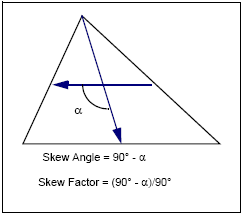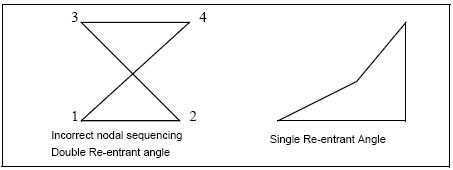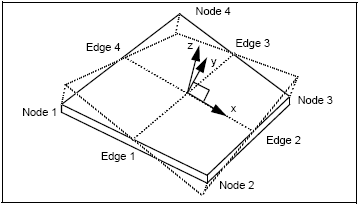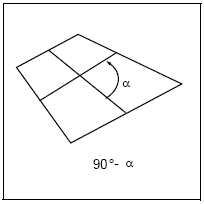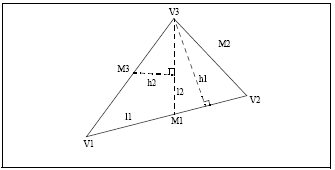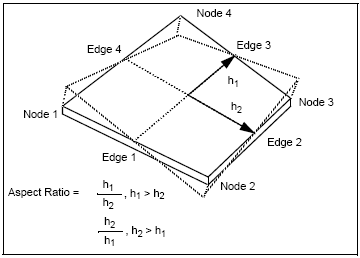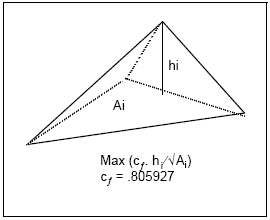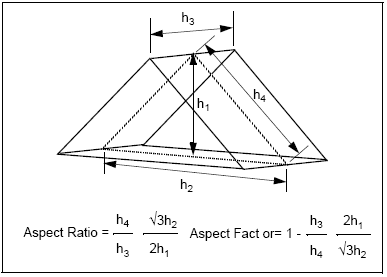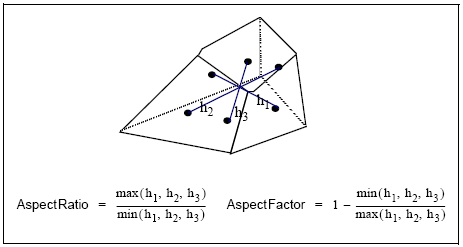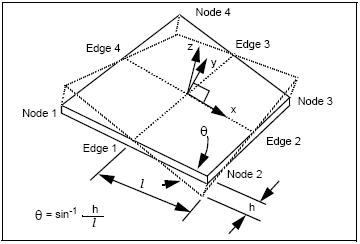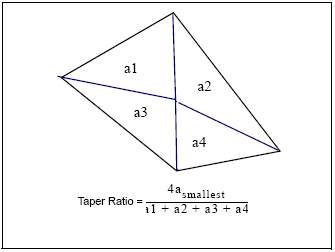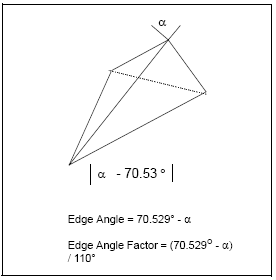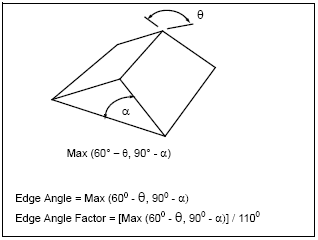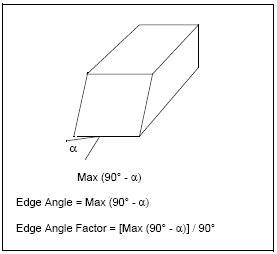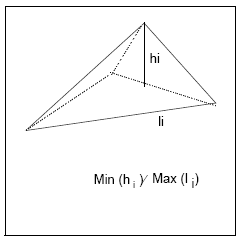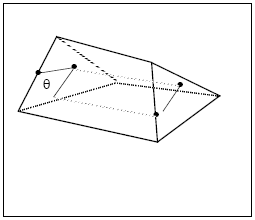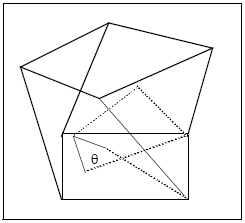XXXXXXXXXXXXXXXXXXXXXXXXXXXXXXXXXXXXXXXXXXXXXXXXXXXXXXXXXXXXXXXXXXXXXXXXXXXXXXXXXXXXXXXXXXXXXXXXXXXXXXXXXXXXXXXXXXXXXXXXXXXXXXXXXXXXXXXXXXXXXXXXXXXXXXXX''"> Theory
Skew
Tria
Three potential skew angles are computed for each tria element. To calculate each skew angle, two vectors are constructed: one from a vertex to the mid-point of the opposite edge, and the other between the mid-points of the adjacent edges. The difference is taken of the angle between these two vectors and 90°. This procedure is repeated for the other two vertices. The largest of the three computed angles is reported as the skew angle for that element.
If Normalize is selected on the verification form, the skew angle is divided by 90° to yield the skew factor. An equilateral triangle will have a skew factor of 0.
For Plots a simplified calculation method is used based on interior angles, where 60° is ideal.
Figure 11‑2 Tria Skew Angle
Quad
Prior to testing for skew, each element is first checked for convexity. Elements which fail the convexity check “double back” on themselves causing their element stiffness terms to have either a zero or
negative value.
Figure 11‑3 Convexity Check
This skew test is based on a reference frame created by first bisecting the four element edges, creating an origin at the vector average of the corners, where the x-axis extends from the origin to the bisector on edge 2. The z-axis is in the direction of the cross product of the x-axis and the vector from the origin to the bisector of edge 3. The y-axis is in the direction of the cross product of the x and z axis as shown in
Figure 11‑4.
Figure 11‑4 The Element Test Coordinate System
The Robinson and Haggenmacher skew test uses the angle alpha between the edge 2 and 4 bisector and the test y-axis. This alpha angle is the skew angle.
If Normalize is selected on the verification form, the skew angle is divided by 90° to yield the skew factor. A square element will have a skew factor of 0.
Figure 11‑5 Quad Skew Angle
Tet
Each face of the tet element is tested for skew as if it were a tria element. See explanation for computation of skew angle -
Tria. The highest resulting angle for each element is retained as the skew angle.
Wedge
Each face of the wedge element is tested for skew as if it were either a quad or tria element. See explanation for computation of skew angle -
Tria or
Quad. The highest resulting angle for each element is retained as the skew angle.
Hex
Each face of the hex element is tested for skew as if it were a quad element. See explanation for computation of skew angle -
Quad. The highest resulting angle for each element is retained as the skew angle.
Aspect Ratio
Tria
Let V1, V2 and V3 be three vertices of a triangle, and M1, M2 and M3 be the bisectors of three edges on the triangle. Let edge1 be the edge from V1 to V2, and segm1 be the line segment from V3 to M1. First, we calculate two intermediate aspect ratios on edge1:
The first intermediate aspect ratio is the ratio of length of edge1, l1, to the height, h1. The ratio is then multiplied by

such that a “perfect” element in the shape of an equilateral triangle will equal one. The ratio is inverted if it is less than one.
The second intermediate aspect ratio is the ratio of the distance from M3 to the segm1, h2, to the length of segm1, l2. The ratio is then multiplied by 4 *

. It is inverted if it is less than one.
The aspect ratio on edge1 is the maximal value of these two intermediate ratios.
This procedure is repeated for the remaining two edges of the triangle, and the largest value is retained as the aspect ratio for the triangle.
If Normalize is selected on the verification form, then the aspect ratio is inverted such that it becomes less than or equal to one. This inverted aspect ratio is subtracted from one to yield the aspect factor. An equilateral triangle will have an aspect factor of 0.
Figure 11‑6 Tria Aspect Ratio
Quad
The aspect ratio for a quad is derived from one test proposed by Robinson and Haggenmacher. This test is based on projection plane created by first bisecting the four element edges, creating a point on the plane at the vector average of the corners. The x-axis extends from the point to the bisector on edge 2. The ratio is determined as the ratio of the length from the origin to the bisector of edge 2 and the length from the origin to the bisector of edge 3. If the ratio is less than 1.0, it is inverted.
If Normalize is selected on the verification form, then the aspect ratio is inverted such that it becomes less than or equal to one. This inverted aspect ratio is subtracted from one to yield the normalized aspect ratio. A square element will have a normalized aspect ratio of 0.
Figure 11‑7 Quad Aspect Ratio
Tet
The aspect ratio for a tet element is computed by taking the ratio of the height of a vertex to the square root of the area of the opposing face. This value is then manipulated in one of two ways, depending on whether the Normalize parameter is selected on the verification form.
If Normalize is NOT selected, the maximum height to area value is multiplied by a factor

, which is the ratio of height to edge length for an equilateral tetrahedron. This result is reported as the Aspect Ratio. An equilateral tet will report a value of 1.
Aspect Ratio =

.
If Normalize IS selected, the maximum height to area value is inverted and subtracted from 1. Aspect Factor =

Figure 11‑8 Tet Aspect Ratio
Wedge
Patran averages the two triangular faces of the wedge element to obtain a mid-surface. The aspect ratio of this triangular mid-surface is computed

. Next the height (h
1) of the wedge is compared to the maximum edge length of the mid-surface (h
4).
If the height of the wedge is greater than the maximum edge length then the aspect ratio for the wedge element equals the mid-surface aspect ratio multiplied by the maximum edge length divided by the distance between the triangular faces (h3).
If the height of the wedge is less than the maximum edge length then the aspect ratio for the wedge element equals either the mid-surface aspect ratio or the maximum edge length divided by the distance between the triangular faces, whichever is greater.
If Normalize is selected on the verification form, then the aspect ratio is inverted such that it becomes less than or equal to one. This inverted aspect ratio is subtracted from one to yield the aspect factor. An equilateral wedge element will have an aspect factor of 0.
Figure 11‑9 Wedge Aspect Ratio
Hex
The aspect ratio is calculated as the ratio of the distance between opposing faces. This distance is determined by treating each HEX face as if it were a warped quadrilateral. Each face is processed to produce a projected plane. The distances between the centerpoints of all three pairs of opposing faces are compared.The aspect ratio is determined by taking the maximum distance between any two faces and dividing it by the minimum distance between any two faces.
If Normalize is selected on the verification form, then the aspect ratio is inverted such that it becomes less than or equal to one. This inverted aspect ratio is subtracted from one to yield the aspect factor. A cubic element will have an aspect factor of 0.
Figure 11‑10 Hex Aspect Ratio
Warp
Quad
The warp test is a test proposed by Robinson and Haggenmacher which uses the following method of calculating the Quad element Warp. This test is based on a projection plane created by first bisecting the four element edges, creating a point on the plane at the vector average of the corners, where the x-axis extends from the point to the bisector on edge 2. The plane normal is in the direction of the cross product of the x-axis and the vector from the origin to the bisector of edge 3. Every corner of the quad will then be a distance “h” from the plane. The length of each half edge is measured and the shortest length is assigned “l.” The warp angle is the arcsine of the ratio of the projection height “h” to the half edge
length “l.”
If Normalize is selected on the verification form, the warp angle is divided by 15° to yield the warp factor. A planar element has a warp factor of 0.
Figure 11‑11 Quad Warp Angle
Wedge
Each quad face of the wedge element is tested for warp as if it were a quad element. See explanation for computation of warp angle -
Quad. The highest resulting angle for each element is retained as the warp angle.
Hex
Each face of the hex element is tested for warp as if it were a quad element. See explanation for computation of warp angle -
Quad. The highest resulting angle for each element is retained as the
warp angle.
Taper
Quad
The taper test is a test proposed by Robinson and Haggenmacher1 which uses the following method of calculating the Quad element. Taper four triangles are created bounded by the element edge and the edges created by connecting the element verification reference frame origin with the two nodes at the element edge. The resulting four triangular areas are calculated and then summed. The ratio of the area with the smallest triangle and the total area of the element is taken as the taper ratio.
If Normalize is selected on the verification form, the taper ratio is subtracted from one to yield the taper factor. A square element has a taper factor of 0.
Figure 11‑12 Quad Taper
Wedge
Each quad face of the wedge element is tested for taper as if it were a quad element. See explanation for computation of taper -
Quad. The lowest resulting value for each element is retained as the value of face taper.
Hex
Each face of the hex element is tested for taper as if it were a quad element. See explanation for computation of taper -
Quad. The lowest resulting value for each element is retained as the value of
face taper.
Edge Angle
Tet
Edge angle measures the angle between adjacent faces of the tetrahedral element. In an equilateral tetrahedral element, this angle will equal 70.529°. The largest angle found in the element is retained. Patran then computes the absolute value of the difference between the measured angle and 70.529°. This is the value reported as the Edge Angle.
If Normalize is selected on the verification form, the edge angle is divided by 110° to yield the edge angle factor. An equilateral tet will have an edge angle factor of 0.
Figure 11‑13 Tet Edge Angle
Wedge
An edge angle is the absolute value of the angle between the two faces meeting at an edge subtracted from the ideal angle for that edge. The ideal angle between two quad faces is 60 degrees, and the ideal angle between a quad face and a tria face is 90 degrees. For warped quad faces, the projected plane of the face is used to compute the face normal used in the angle calculation. The maximum edge angle is calculated for each wedge element.
If Normalize is selected on the verification form, the edge angle is divided by 110° to yield the edge angle factor.
Figure 11‑14 Wedge Edge Angle
Hex
An edge angle is the absolute value of the angle between the two faces meeting at an edge subtracted from the ideal angle for that edge. The ideal angle between faces of a hex element is 90 °. For warped faces, the projected planes for each face is used to compute the face normals used in the angle calculation. The maximum edge angle is calculated for each hex element.
If Normalize is selected on the verification form, the edge angle is divided by 90° to yield the edge angle factor.
Figure 11‑15 Hex Edge Angle
Collapse
Tet
Collapse is an indicator of near zero volume tetrahedral elements. The test takes the ratio of the height of a vertex to the square root of the area of the opposing face. This value approaches zero as the volume of the element approaches zero.
If Normalize is NOT selected on the verification form, the minimum height to area value is multiplied by a factor C
f = 0.805927, which is the ratio of height to edge length for an equilateral tetrahedron. An equilateral tet will report a value of 1. Collapse =

. The The tet collapse ratio is the same as the icon on the form: Min(hi) / Max(li). This value can range from 0 to sqrt(2/3) = 0.816496581.
If Normalize IS selected, the minimum height to area value is subtracted from 1. An equilateral tet will report a value of 0. Collapse Factor =

. The normalized value is: 1-(collapse ratio). This value can range from 0.183503419 to 1.
Figure 11‑16 Tet Collapse
Twist
Wedge
Twist is the rotation of one face of a solid with respect to its opposite face. To compute twist angle, normals are drawn from the center of each tria surface. These vectors are projected onto a plane. The angular difference between the two vectors is the twist angle.
If Normalize is selected on the verification form, the twist angle is divided by 60° to yield the twist factor.
Figure 11‑17 Wedge Twist Angle
Hex
Twist is the rotation of one face of a solid with respect to its opposite face. A twist angle is computed about all three principal axes of hex elements. To compute the twist angle, each face is treated as if it were a warped quad. Vectors from the center of the projected plane to the middle of two adjacent edges are constructed. The vectors are summed to compute a reference vector. The same steps are performed for the opposite face. A line through the center of each projected face and the plane normal to this line is determined. The two reference vectors are projected onto this plane and the angular difference between them is measured. The highest angle found is retained as the twist angle.
If Normalize is selected on the verification form, the twist angle is divided by 90° to yield the twist factor.
Figure 11‑18 Hex Twist Angle
